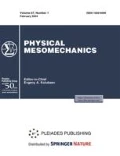Abstract
Attempts to improve the osteointegration, fixation and stability of Ti-base implants have been focused by producing a significative surface roughness that enhances the surface area available for bone/ implant apposition. In this research study, it shows the experimental data by synchrotron radiation X-ray diffraction (SR-XRD) of the main material surface properties (residual stress and cold work) that changed significantly during the application of different surface treatments such as grit blasting and laser shock peening in a biometallic Ti–6Al–4V alloy. The ratio of residual stress to cold work is primarily determined by the material and the specific surface treatment applied. In order to establish how they alter the recorded magnetic signatures and to validate that the residual stress and cold work effects govern the outcome of the magnetic measurements, we used a nondestructive magnetic method. It was displayed that the magnetic method provides the unique capability of nondestructively sensing the thermomechanical relaxation below the treated surface only calculating the normal and tangential magnetic intensities induced by thermocurrents using a fluxgate magnetometer.








Similar content being viewed by others
REFERENCES
Carreon, H., Thermoelectric Detection of Inclusions in Metallic Biomaterials by Magnetic Sensing, AIP Adv., 2017, vol. 7, pp. 1–6.
Caballero, F.G., Capdevila, C., Alvarez, L., and García de Andrés, C., Thermoelectric Power Studies on a Martensitic Stainless Steel, Scripta Mater., 2004, vol. 50, pp. 1061–1066.
Kleber, X., Detection of Surface and Subsurface Heterogeneities by the Hot Tip Thermoelectric Power Method, NDT E Int., 2008, vol. 41, pp. 364–370.
Kawaguchia, Y. and Yamanakab, S., Mechanism of the Change in Thermoelectric Power of Cast Duplex Stainless Steel Due to Thermal Aging, J. All. Compound., 2002, vol. 336, pp. 301–314.
Carreon, H., San Martin, D., Caballero, F.G., and Panin, V.E., The Effect of Thermal Aging on the Strength and the Thermoelectric Power of the Ti–6Al–4V Alloy, Phys. Mesomech., 2017, vol. 20, no. 4, pp. 447–456.
Faidi, W.I. and Nayfeh, A.H., The Thermoelectric Magnetic Field of Isotropic Inclusions in Anisotropic Metals, Eur. Phys. J. Appl. Phys., 2006, vol. 33, pp. 115–120.
Multigner, M., Frutos, E., Mera, C.L., Chao, J., and González-Carrasco, J.L., Interrogations on the Sub-Surface Strain Hardening of Grit Blasted Ti–6Al–4V Alloy, Surf. Coat. Tech., 2009, vol. 203, pp. 2036–2040.
Montross, S., Wei, T., Ye, L., Clark, G., and Mai, Y.W., Laser Shock Processing and Its Effects on Microstructure and Properties of Metal Alloys: A Review, Int. J. Fatigue, 2002, vol. 24, pp. 1021–1036.
Xia, L., Geng, J., Yang, H., Wang, Y., Fu, Z., and Meng, B., An Optimized Two-Step Magnetic Correction Strategy by Means of a Lagrange Multiplier Estimator with an Ellipsoid Constraint,Sensors, 2018, vol. 18, pp. 3284.
Ding, Z., Yuan, J., and Long, X., Response of a Bell-Bloom Magnetometer to a Magnetic Field of Arbitrary Direction,Sensors, 2018, vol. 18, pp. 1401.
Warren, A.W., Guo, Y.B., and Chen, S.C., Massive Parallel Laser Shock Peening: Simulation, Analysis, and Validation, Int. J. Fatigue, 2008, vol. 30, pp. 188–197.
Kim, J.H., Kim, Y.J., and Kim, J.S., Effects of Simulation Parameters on Residual Stresses for Laser Shock peening finite element analysis, J. Mech. Sci. Tech., 2013, vol. 27, no. 7, pp. 2025–2034.
Funding
This work was performed at UMSNH-MEXICO with partially funding from CONACYT-MEXICO under project CB-2015/256013. The authors are grateful to Jose L. Gonzalez-Carrasco (CENIM) for the experimental support in the surface treatment processes.
Author information
Authors and Affiliations
Corresponding author
Additional information
Russian Text © The Author(s), 2019, published in Fizicheskaya Mezomekhanika, 2019, Vol. 22, No. 3, pp. 106–111.
Rights and permissions
About this article
Cite this article
Carreón, H., Carreon, M.L. & Carreon-Garcidueñas, M. Nondestructive Magnetic Monitoring of Residual Stresses in a Medical Ti–6Al–4V–ELI Alloy Using a Fluxgate Sensor. Phys Mesomech 23, 160–166 (2020). https://doi.org/10.1134/S1029959920020071
Received:
Revised:
Accepted:
Published:
Issue Date:
DOI: https://doi.org/10.1134/S1029959920020071




